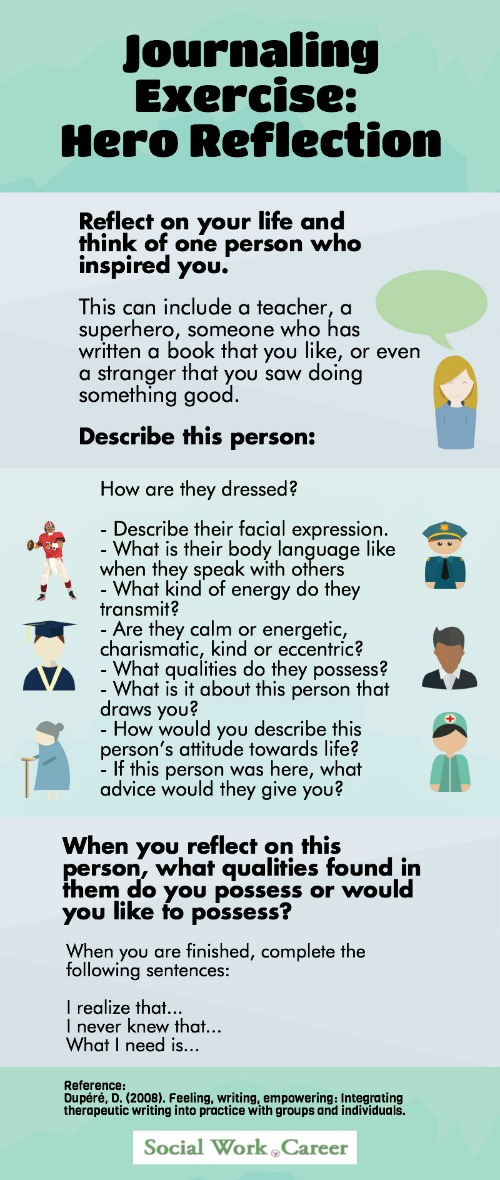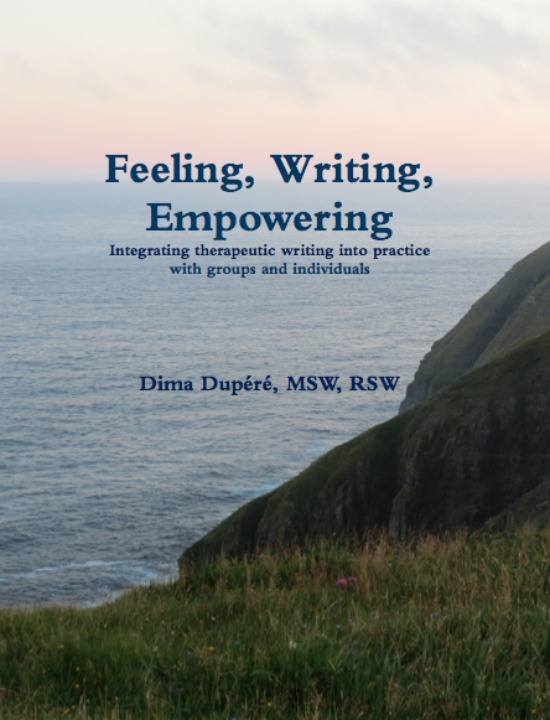How Therapeutic Journaling Can Empower You/Your Client
Have you wanted to use journaling as a therapeutic method with clients? Or have you wanted to try to engage in writing as a method of self-care or self-expression?
If yes, you are likely to find Dima Dupéré’s book: Feeling, Writing, Empowering [Integrating Therapeutic Writing into Practice with Groups and Individuals], most helpful.
Amy Knitzer, LCSW provides us with her thoughts about the book and how its techniques can help you and your clients gain insight into your emotions and create a different future. We also have the good fortune of Dima Dupéré, MSW, RSW, sharing with us some valuable learnings from her work.
Guest Post by Amy Knitzer, LCSW
Dima Dupéré, true to her word, provides a short study for professionals on the benefits of journaling, with loads of examples of writing exercises and their benefits.
She feels writing can be a wonderful adjunct for clients in individual or group therapy, and for people who sign up for more informal community groups as well. Witnessing is the key, she says, that moves people along in their thinking, and writing enables this clarity of vision and insight to emerge.
The author cites studies showing how writing benefits our immune system, health and mental health. The benefits include, allowing us to “make sense of our experiences,” “release stress” that has impacted the body/health; “re-experience trauma in a situation thatʼs safe…;” and help us see problems more objectively and to aid in decision-making.
While these are pretty lofty goals, many illustrations are given to guide you on how to structure these writing exercises, what benefits they yield, and how to assess your (or your client’s) progress.
The section of the book that is most substantial and clearly tied to social work is called Integrating Practice with Theory. In this part, Dupéré lists various social work models and builds exercises around these.
For example, in the ecosystem/systems theory approach, we are taught to look at the influences in a clientʼs life, from support systems, to landlords, to schools, workplace and other organizations.
Using this approach, you may want to ask a client to write a dialogue about a problem in one of those systems, recording thoughts from her/his vantage point, as well as the other person’s point of view such as the teacherʼs, landlord’s or employer’s etc.
As the client will be writing out the conversation, she is likely to see things more clearly from the other person’s perspective. This practice serves as a trial run for the brain. In fact, when you’re able to discuss the issue with the client following the writing exercise, the rehearsal may help her/him productively resolve it.
In the strength-based model, a writer will record some of the things she has handled well in life, building confidence and momentum toward handling other issues.
We all have a life story, and we are all influenced by the telling of it. In a narrative therapy approach, the client can re-write her own story “in a more positive manner to find new meaning and direction.” People who have suffered abuse, trauma, depression and difficult life circumstances can potentially benefit from journaling.
 Dupéré was inspired by the work of Ira Progoff, who published a book on using meditation and journaling, back in the 1970ʼs. He, in turn, was influenced by the work of Carl Jung.
Dupéré was inspired by the work of Ira Progoff, who published a book on using meditation and journaling, back in the 1970ʼs. He, in turn, was influenced by the work of Carl Jung.
Thus many of Dupéréʼs exercises tap into dreams, objects, metaphors, and lead clients to learn about their own patterns and make significant connections between past experiences and current behavior.
Other writing exercises the author recommends include writing a “resume of life skills (not job skills);ʼ writing about “unfinished business;” “changing your perceptions;” “decorating your interior landscape;” and using props, or random words to jump-start the process of creative, exploratory writing.
In general, there are three types of relationships that can be written about–relating to self, others and systems. Dupéré shares examples of writing prompts and client writing.
This book offers a potentially valuable tool therapists can add to their repertoire of skills in helping a variety of clients and issues.
For those who wish to offer writing workshops or who rely heavily on writing exercises as an adjunct to treatment, “Feeling Writing, Empowering” is a must.
Interview with the author, Dima Dupéré:
Are you sometimes surprised by the people who seem to benefit from journaling?
I am always in awe at the power of words and images and how they can reach individuals. I first began this work with groups. As such, the participants came because they had an interest in journal writing or wanted to try it out.
Even within that context, individuals surprised themselves with the insights they found; with the depth of their writing, with their personal honesty, with their willingness to reach deeper and explore their feelings.
Do you market your services as a mix between psychotherapy and journaling?
My full time work is as a mental health counselor. In that position, I integrate therapeutic writing within my clinical approach. I don’t see it as a separate thing. Therapeutic writing reflects many approaches: solution-focused, gestalt, strength-based, narrative therapy, and ecosystemic.
I spend some time getting to know my clients before suggesting writing to some of them. I start with basic exercises like having them draw a type of genogram of their family and show me on their map the relationships, ages, personalities.
Based on this exercise, I can gauge the client’s comfort in trying something a little less conventional. If I sense extreme resistance, I put that thought aside and try to find another way to reach the client. Other clients embrace the opportunity.
I have one client with whom I almost only do writing and art exercises during the sessions. She pours herself into the experience completely and together we explore her work. Dealing with health issues, we have used many of the exercises in the book to look at her fears, her strengths, her goals, her frustration with the medical system, and her self-concept.
Dialogue is a powerful exercise, as has been writing letters to her emotions, her body, and her friends, writing herself a get-well card, and exploring her self-image through collages. In the manner of narrative therapy, she created pain as a monster outside herself and then created an image of herself as a superhero fighting the pain.
These writings and creative expressions open the door to a telling and re-telling of her personal story, in which she becomes the heroine, and becomes more and more aware of her resilience.
In general, are people open to learning about themselves through writing?
Some clients, like the example shared earlier embrace writing as a powerful tool in their healing. They will sit and write in the session. Other clients are more apt to reflect and write in their private journal between sessions and share that with me. Others will write and not share. Others have no desire to write.
I try to reach the client where they are and find methods of expression that work with their personality. For some, I ask them to bring in photograph from their lives or from their childhood and ask them to tell me the stories that accompany them.
Since some of my clients are deaf, I also encourage some of them to keep video journals as a way to fully express their emotions without the delay/frustration of having an interpreter. They can then watch the video and observe their own thoughts and insights in the same way someone who writes in a journal can. The most important elements are expression and reflection; however we can make that happen.
I also believe in modeling the behavior. I have created a journal/art journal as an example for clients. They can look at it any time for ideas. I also have blank journals available for anyone who wants them. The door is open and I try to let them guide where they want to go. I never force anyone to use this approach if they are not comfortable with it.
I gave a journal to a client and encouraged him to fill it with self-care strategies, calming photos, etc. He returned with something completely different but very powerful. He had taken different photos of himself, in different moods and situations and added words to the photos that encouraged self-care and social support.
Can you describe how you work with people who have had hearing loss and how journaling helps facilitates that process?
Journaling does not facilitate the process for those who are deaf because, for many of them, written language is not comfortable. I tend to use more visual prompts; pictures from magazines, photographs, doing art work or suggest they do video journals to express themselves.
Many of the exercises outlined in the book could be completed in sign language and recorded on video. In the same way individuals don’t have to share what they have written, they do not have to share their video with their therapist.
What I ask them to share is their reaction to the exercise by answering the following statements:
1- I didn’t know that…
2- I realize that…
3- What I need is…
Journal writing will work much better for someone who is deafened (has lost their hearing, gradually, and sometimes suddenly). Communication can become extremely difficult overnight. Having an outlet to express what they are feeling in writing can be a great relief to them.
As with any clinical intervention, it is crucial to be mindful of culturally sensitive and anti-oppressive approaches.
Example: It would be insensitive to use the exercises as is with Deaf clients or expect them to write out stories or dialogues. In the same way, I would not expect immigrants to write in English. The good thing about this technique is that individuals can write in their language.
Why is the written language uncomfortable for many Deaf clients? Is it because of the way we learn written language, through speaking and listening, but clients who are Deaf do not get to learn it this way and thus written language feels awkward to/for them?
Yes, exactly. For Deaf individuals, their first language is sign language, which is visual and has a different structure and grammar.
English is difficult to learn if you have never heard it. We will say things like ‘putting the cart before the horse’, which makes no sense when translated into sign language… Why is there suddenly a horse in your explanation?
This is why using sign language interpreters is preferred over writing notes to communicate with those who are Deaf.
Thanks so much, Dima, for introducing us to some of the empowering techniques of journaling, as well as informing us about some cultural sensitivities we need to be aware of when working with clients who are Deaf!
Interested in purchasing this book? Dima has a special $5.99 sale on her second edition version for the month of November, 2015.
About the author: Amy Knitzer, LCSW is a social worker with many years of experience working with inner-city children and families. Currently, she is counseling and running support groups for elderly residents, as well as for survivors of suicide loss. In addition, she acts with the New Jersey Mental Health Players, a troupe that reenacts mental health issues for audiences and helps de-stigmatize mental illness.
What are your thoughts about journaling? What experience have you had in using journaling for self-expression and/or as a therapeutic method with clients?
Like this content? Share your thoughts below and sign up for more posts like these !
Disclosure of Material Connection: I received one copy of the book mentioned above for free in the hope that I would mention it on my blog. Regardless, I only recommend products or services I use personally and believe will be good for my readers. I am disclosing this in accordance with the Federal Trade Commission’s 16 CFR, Part 255: “Guides Concerning the Use of Endorsements and Testimonials in Advertising.”




I think I will buy your book. I know writing is important-I remember my lonely dad writing little notes to himself as he sat at his easy chair. I would read what he wrote and could see how lonely he was. My mom was the same only she wrote in short stories and little notes and doodling. I write on the computer long drawn out letters and then erase them so no one will read them. I write on yearly calendars and hide them so I can reflect back to see any growth or change.
I received my MSW in 2009 in Washington state. I cannot get licensed or am having trouble getting licensed. It is frustrating. I have checked everywhere, the DOH, done it all. No luck. Am now looking for any states which might take me in and help me work and eventually get licensed.
Currently in China, working as an English teacher for one year.
Donna
Thanks Donna! Specific writing exercises can be very helpful. I wish you the best in your endeavours.
Congratulations on what sounds like an amazing book Dima. I hope it finds lots of users who can discover deeper ways to empower and deepen those they are working with. I know I have found your work very powerful whenever I have used it in my retreat work, or personally.
Take care.
Thank you very much, Sharon.
I believe in the power of writing to heal. Whether that writing is a poem, a story, a journal, a memoir, or just random words. This is very important information to share with everyone. The book sounds terrific.
Hi Terry,
Thank you for sharing your thoughts about the use of writing for healing. I’m so glad that you found this information valuable.
I’ll make sure to share your kind feedback to both the guest author (Amy) and the book author (Dima).
Thank you Terry. It doesn’t matter if people can’t spell, or use oroprer grammar. The point is get it out, and express it. Words are incredibly powerful.
Hello Dima and Dorlee. Thanks for sharing about this book here. I’m excited for what it stands for, and the examples and exercises you provided in this article are wonderful resources. I can’t wait to share a conversation with you Dima on the JournalTalk podcast!! http://www.Write4Life.us/JournalTalk. Many blessings to you.
Thank you Nathan, I look forward to it as well.
Thank you, Nathan.
I’m looking forward to your upcoming podcast interview with Dima !